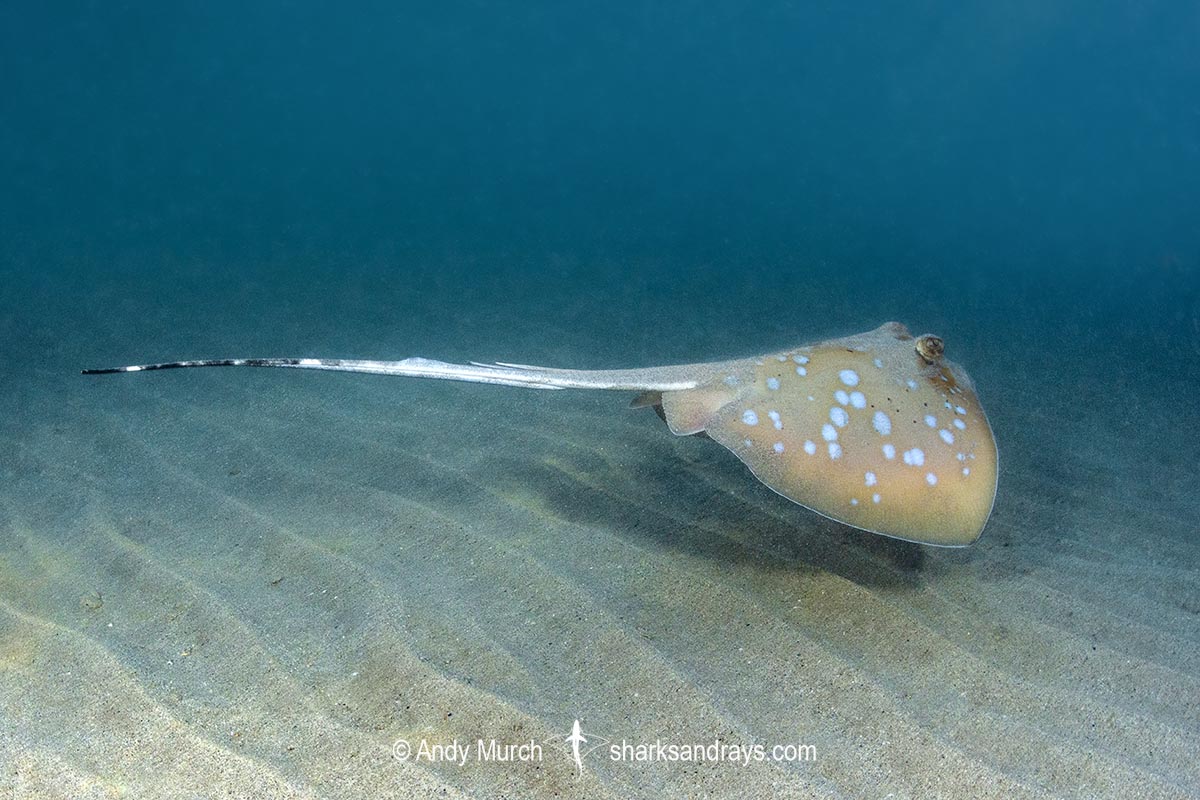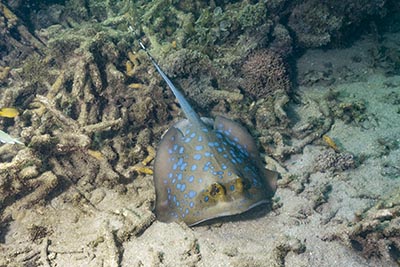Common names
Australian Bluespotted Maskray, Bluespotted Maskray.
Binomial
Neotrygon australiae.
Synonyms
None.
Identification
A small stingray with a kite-shaped disc that is wider than long; disc width approximately 1.2-1.3 x length. Snout very short, and bluntly angular. Tip of snout not extended. Anterior margins of disc weakly convex. Pectoral fin apices angular. Pelvic fins large; apices narrowly rounded.
Eyes large and protruding. Snout length 0.8-1.2 x combined eye and spiracle length.
Mouth small, containing 2 large central oral papillae. Prominent labial furrows and folds around mouth. Nasal curtain narrow and skirt-shaped; posterior margin undulate and heavily fringed. Nostrils thin.
Denticles on disc absent except for a varying row of small thorns extending from nape to level of cloaca. Tail broad and depressed at base, tapering gently to caudal sting, then thin but firm to tip. No prickly denticles on tail. Tail length (when intact) up to 1.5 x disc width. Ventral finfold long and low. Dorsal finfold very short; length approximately 4-6.6 x shorter than ventral fold. 1-2 tail stings usually present.
Colour
Dorsum Yellow-brown with a distinct but dusky brown band across eyes, and numerous eye-sized blue spots, often with pale centres. Spots sparser and smaller towards disc margin. Ventrum white with a greyish submarginal band. Tail beyond caudal fades to black with irregular white bands. Caudal finfolds mostly black.
Size
Maximum disc width 38cm. Disc width at birth unknown.

Conservation Status
NEAR THREATENED
The Australian bluespotted maskray is a targeted and bycatch component in artisanal and industrial trawl fisheries throughout most of its range. It is retained for consumption in Indonesia, but it is discarded in Australia and PNG. The Indonesian population is suspected to be stable or increasing but this represents a small part of the species’ range. Overall, the Australian Bluespotted Maskray is thought to have declined by 20–29% over the past three generation lengths (24 years).
Habitat
Tropical seas. On sandy substrates, often adjacent to reefs. From 23-91m.
Distribution
In Australia from Shark Bay in Western Australia to Cape Tribulation, northward to southern Indonesia; Nusa Tenggara Archipelago to southern West Papua, East Timor, and possibly southern PNG.
Reproduction
Matrotrophic aplacental viviparity. Litter size unknown.
Diet
Diet unknown.
Behavior
Sedentary. Behavior poorly known.
Reaction to divers
Shy and difficult to approach unless extremely accustomed to divers.
Diving logistics
Although the Australian bluespotted maskray is probably quite common in northern Australia, conditions in the Northern Territory are far from ideal for scuba diving due to high levels of run off from numerous rivers, and because of the danger of encountering saltwater crocodiles. Consequently, most Australian encounters occur in northern WA. Exmouth is probably the best area to look for this ray within Australia.
In Indonesia, diving conditions are much more favourable. Australian bluespotted maskrays are seen at hundreds of dive sites from The Nusa Tenggara to PNG.
What’s new
View our full list of updates
Similar species
Bluespotted Maskray (Neotrygon caeruleopunctata) A virtually identical species from Bali and the south coast of Java.
Oriental Bluespotted Maskray A very similar ray. Distinguishable by blue spots that concentrated on the pectoral fins and less dense on the medial strip of the disc. Plus, more northerly (but likely overlapping) range.

